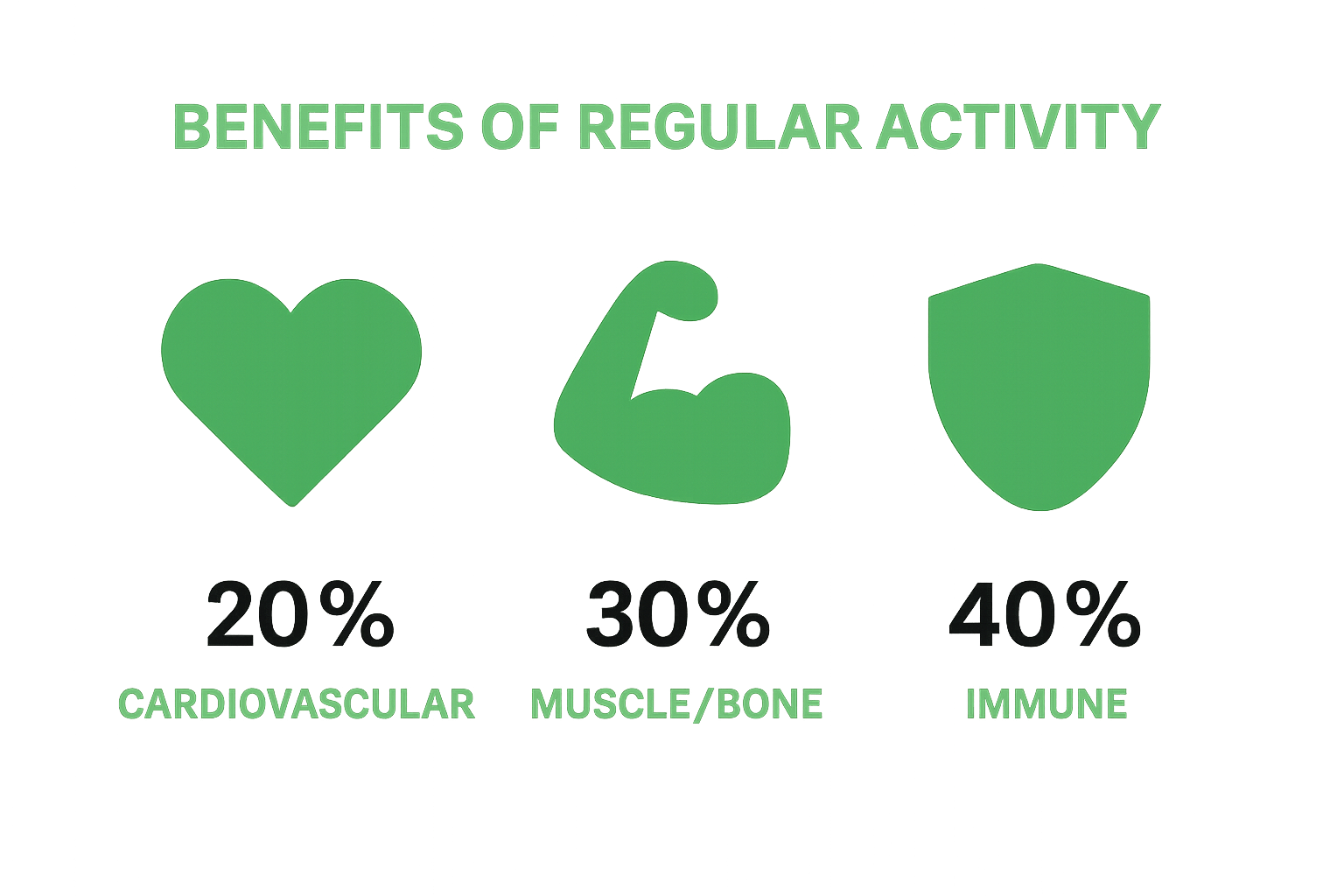Living an active lifestyle means more than squeezing in a workout now and then. People who keep moving regularly can slash their risk of major illnesses by up to 30 percent, according to the UK National Health Service. That figure sounds powerful but what most folks do not realize is that even small changes like taking the stairs or adding short walks can make a bigger difference than any one gym session ever could. The real breakthrough comes from weaving movement into your daily life in simple ways you might never expect.
Table of Contents
- What Is An Active Lifestyle And Why Does It Matter?
- The Benefits Of An Active Lifestyle For Physical Health
- Mental And Emotional Advantages Of Staying Active
- How Technology Supports An Active Lifestyle
- Integrating Active Living Into Daily Routines
Quick Summary
| Takeaway | Explanation |
|---|---|
| Engage in regular physical activity | Consistent movement, whether exercise or daily tasks, is essential for holistic health. |
| Prioritize diverse movement patterns | Incorporating various activities enhances physical capabilities and prevents monotony in exercise routines. |
| Leverage technology to track fitness | Use smart devices and apps to monitor activity levels and remain accountable for health goals. |
| Integrate movement into daily routines | Small changes, like active commuting and using stairs, can significantly increase daily physical activity. |
| Recognize the mental health benefits | Regular physical activity improves mood, cognitive function, and overall emotional resilience. |
What is an Active Lifestyle and Why Does It Matter?
An active lifestyle represents more than occasional exercise. It is a comprehensive approach to integrating consistent physical movement and purposeful activity into daily routines, promoting holistic health and well-being. According to the Centers for Disease Control and Prevention, physical activity is fundamental to maintaining optimal health and preventing chronic diseases.
Understanding Physical Activity Fundamentals
Physical activity encompasses a wide range of movements that elevate energy expenditure above resting levels. This includes structured exercises like gym workouts, recreational sports, and everyday activities such as walking, gardening, or climbing stairs. The key distinction is consistent, intentional movement that challenges your body’s capabilities.
Key characteristics of an active lifestyle include:
- Regular engagement in physical activities
- Diverse movement patterns
- Intentional energy expenditure
- Consistent commitment to bodily movement
Health Implications of an Active Lifestyle
Physical Benefits:
- Improved cardiovascular health
- Enhanced muscle strength and flexibility
- Better weight management
- Increased metabolic efficiency
Mental and Emotional Advantages:
- Reduced stress levels
- Improved mood and mental clarity
- Enhanced cognitive function
- Greater emotional resilience
The World Health Organization emphasizes that physical activity is crucial for preventing noncommunicable diseases like heart disease, diabetes, and certain cancers. By making movement a consistent part of your daily life, you proactively invest in your long-term health and wellness.
Below is a table that summarizes the core physical and mental health benefits of maintaining an active lifestyle, helping to distinguish how regular movement contributes to holistic well-being.
| Benefit Type | Specific Advantages |
|---|---|
| Physical | Improved cardiovascular health, muscle strength, weight management, metabolic efficiency |
| Mental & Emotional | Reduced stress, improved mood, enhanced cognition, greater emotional resilience |
The Benefits of an Active Lifestyle for Physical Health
An active lifestyle offers profound advantages for physical health, transforming the body’s fundamental systems and promoting long-term wellness. According to the UK National Health Service, regular physical activity can reduce the risk of major illnesses by as much as 30%, demonstrating the transformative power of consistent movement.
Cardiovascular and Metabolic Improvements
Regular physical activity dramatically enhances cardiovascular function and metabolic efficiency. When you engage in consistent exercise, your heart becomes stronger, blood circulation improves, and your body becomes more adept at processing nutrients and regulating energy metabolism. This leads to significant improvements in overall physiological performance.
Key cardiovascular benefits include:
- Reduced risk of heart disease
- Lower blood pressure
- Improved cholesterol levels
- Enhanced oxygen delivery to tissues
Musculoskeletal and Immune System Enhancements
Physical activity plays a critical role in maintaining and improving musculoskeletal health. Consistent movement strengthens muscles, increases bone density, and supports joint flexibility. Moreover, regular exercise stimulates the immune system, helping the body defend against infections and reducing inflammation.
Additional physical health advantages encompass:
- Increased muscle strength and endurance
- Better balance and coordination
- Enhanced bone mineral density
- Improved immune system response
For those looking to track and optimize their fitness journey, check out our Exercise Calculator to monitor calories burned and progress. By understanding and quantifying your physical activity, you can make more informed decisions about your health and wellness strategies.
Mental and Emotional Advantages of Staying Active
The Mental Health Foundation highlights that physical activity goes far beyond physical fitness, playing a crucial role in mental and emotional well-being. Regular movement serves as a powerful mechanism for managing psychological health, offering profound benefits that extend well beyond simple exercise.
Neurochemical and Mood Regulation
Physical activity triggers the release of powerful neurochemicals that directly influence emotional states. Endorphins and neurotransmitters like serotonin are naturally produced during exercise, creating a biological pathway for mood enhancement and stress reduction. These neurochemical changes result in immediate and long-term emotional regulation, helping individuals manage complex psychological challenges.
Key neurological benefits include:
- Natural mood elevation
- Reduced stress hormone production
- Enhanced brain chemical balance
- Improved emotional resilience
Psychological Wellness and Cognitive Function
Consistent physical activity serves as a comprehensive mental health intervention. Exercise promotes cognitive flexibility, reduces symptoms of anxiety and depression, and builds psychological resilience. By challenging the body, individuals simultaneously strengthen their mental frameworks, developing better coping mechanisms and emotional intelligence.
Psychological advantages of an active lifestyle encompass:
-
Increased self-confidence
-
Better stress management skills
-
Enhanced mental clarity
-
Reduced risk of depression
For individuals interested in understanding the deeper connections between physical activity and emotional health, explore our comprehensive guide on mindfulness in health and fitness. By integrating mindful movement, you can unlock powerful strategies for comprehensive mental and physical wellness.
How Technology Supports an Active Lifestyle
The American Psychological Association highlights how digital tools are revolutionizing personal fitness, transforming the way individuals approach physical activity and wellness. Technology has become an essential companion in maintaining and enhancing active lifestyles, providing unprecedented support and motivation.
Digital Fitness Tracking and Performance Monitoring
Smart devices and mobile applications now offer comprehensive fitness tracking capabilities, enabling individuals to monitor their physical activity with remarkable precision. These technological solutions capture detailed metrics such as steps taken, calories burned, heart rate, sleep quality, and exercise intensity. By providing real-time feedback and comprehensive performance analytics, these tools empower users to set realistic goals and track their progress systematically.
Key technological tracking features include:
- Detailed activity logging
- Personalized fitness recommendations
- Goal setting and progress visualization
- Performance trend analysis
Interactive Fitness Platforms and Community Engagement
Modern technology transcends individual tracking by creating dynamic, interconnected fitness ecosystems. Online platforms and mobile applications enable users to connect with fitness communities, participate in virtual challenges, and receive personalized coaching. These interactive technologies transform exercise from a solitary activity into a collaborative, motivational experience.
Benefits of digital fitness platforms encompass:
- Global fitness community connections
- Virtual workout classes
- Peer motivation and accountability
- Customized training programs
Explore how technology is changing the way we approach nutrition and fitness, discovering innovative tools that make maintaining an active lifestyle more accessible and engaging than ever before.
Integrating Active Living into Daily Routines
Transforming sedentary habits into an active lifestyle requires strategic planning and mindful choices that seamlessly incorporate movement throughout daily activities. Active living is not about intense workout sessions, but consistently introducing physical activity into everyday experiences.
Workplace and Home Movement Strategies
Modern work environments, particularly those with sedentary desk jobs, present unique challenges for maintaining physical activity. Innovative strategies can help individuals transform traditionally static environments into opportunities for consistent movement. Simple interventions like using standing desks, taking walking meetings, or performing desk-based stretches can significantly increase overall daily activity levels.
Effective movement integration techniques include:
- Using stairs instead of elevators
- Implementing walking breaks during work hours
- Adopting standing or treadmill desk configurations
- Scheduling regular movement intervals
Lifestyle Redesign for Continuous Activity
Creating an active lifestyle involves reimagining routine tasks as potential exercise opportunities. Small, consistent changes can accumulate into substantial physical activity over time.

Practical active living approaches encompass:
-
Walking or cycling for short-distance transportation
-
Active commuting strategies
-
Integrating household chores as exercise
-
Choosing active leisure activities
Learn more about creating a personalized healthy lifestyle that aligns with your unique needs and preferences. By understanding your individual patterns, you can design an active living approach that feels natural and sustainable.
The following table compares strategies for integrating more movement in both workplace and home settings, making it easier to see which tactics align with your daily routines.
| Setting | Strategy Example | How It Increases Activity |
|---|---|---|
| Workplace | Using stairs instead of elevators | Adds more steps to daily routine |
| Workplace | Taking walking breaks during work | Breaks up sedentary periods, boosts circulation |
| Workplace | Standing or treadmill desk setups | Reduces prolonged sitting |
| Home | Walking or cycling for short trips | Encourages active commuting |
| Home | Doing household chores as exercise | Turns daily tasks into fitness opportunities |
| Home | Choosing active leisure activities | Supports ongoing habit formation |
Turn Active Lifestyle Tips Into Real Results With Dietium
You have just learned why consistent physical movement, mindful daily routines, and integrated wellness strategies make such a powerful difference in your health. Yet, you may find it challenging to turn those active lifestyle tips into daily habits that fit your goals and schedule. Overcoming barriers like time management, meal planning, and personalized fitness tracking can feel overwhelming, especially when life gets busy.
Unlock a healthy lifestyle that works for you with Recipians by Dietium. This smart platform gives you tailored meal plans, real-time activity tracking, and easy-to-follow fitness routines—all powered by advanced tools and expert guidance. If you are ready to bridge knowledge with action, get started today and explore the full range of personalized solutions. See the difference an evidence-based, tech-enabled approach can make for your well-being. Make your move now at Dietium.com.
Frequently Asked Questions
What is considered an active lifestyle?
An active lifestyle involves integrating consistent physical movement and purposeful activity into daily routines, such as regular exercise, recreational sports, and everyday activities like walking or gardening.
What are the mental health benefits of an active lifestyle?
An active lifestyle can reduce stress, improve mood, enhance cognitive function, and build emotional resilience through the release of neurochemicals like endorphins and serotonin during physical activity.
How can I incorporate more physical activity into my daily routine?
You can incorporate more physical activity by taking the stairs instead of elevators, scheduling walking breaks during work, using standing desks, and choosing active leisure activities or cycling for short-distance trips.
What technology can help me maintain an active lifestyle?
Smart devices and mobile apps can track your physical activity, provide real-time feedback, and connect you with fitness communities for support and motivation, making it easier to stay engaged in your fitness journey.





